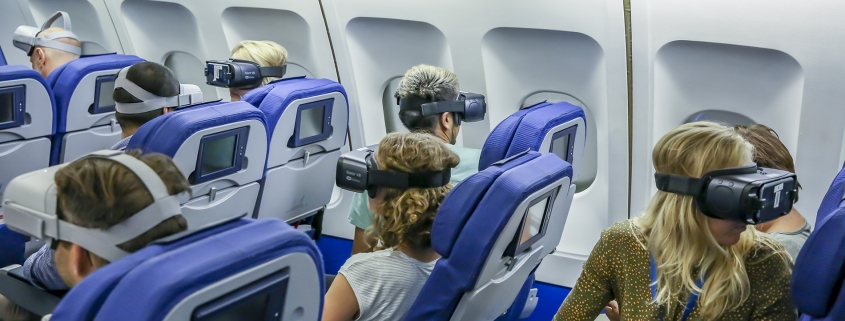KLM and NLR recently studied the effects of passengers using virtual reality headsets in relation to safety, on-board service, experience and comfort. The experiment took place in a KLM cabin simulator at Schiphol-East. Forty KLM volunteers and a crew were exposed to various flight scenarios, ranging from a calm flight to a flight with a rapid decompression. During the flight, the passengers were able to find their way to their transfer gate at Amsterdam’s Schiphol Airport via a 3D presentation on their VR headset. The outcome of the experiment was that while VR has added value for passengers, it also affects communication with the crew and thus possibly also on-board safety. The definitive results are expected this autumn.
Two years ago KLM and NLR were engaged by the European Union, as part of its European Clean Sky project, to conduct a study into the use by passengers of ‘augmented reality’ or ‘virtual reality’ headsets. The emphasis was on identifying potential comfort, communication and safety impediments: how do passengers wearing a headset respond under different conditions to each other and to the crew, and what effect does this have on their own well-being? The hands-on test at Schiphol-East was an important element of the project. Two-thirds of those who participated in the trial were given a VR headset with a presentation enabling them to walk virtually through Schiphol Airport. The other ‘passengers’, a reference group, saw the same app but on their smartphone.
Three flight scenarios were used over two days, each lasting roughly 10 to 20 minutes. The calm scenarios did not reveal anything out of the ordinary, although it was found that the cabin crew had to make a greater effort to establish contact with those wearing the VR headset. Subsequently, a turbulent flight was carried out and, finally, a flight with rapid decompression. This caused the aircraft to shake around violently, there was a lot of noise, lights flashed everywhere, oxygen masks fell from the ceiling and the crew called instructions. Remarkably, various VR headset wearers were unaware of the emergency, because they were entirely absorbed in their virtual world.
After every flight the trial subjects were required to fill in an extensive standardised questionnaire. Video recordings were made to be able to see how passengers responded. The results have yet to be analysed, but the effect that researchers suspected beforehand was apparent during the test, namely that wearing a VR headset affects communication between passengers and crew. Consequently, it might affect the level of on-board service and there is potentially also a safety risk. When developing VR apps, it is important to take these matters into account, bearing in mind that while a VR headset can provide an experience, can be informative and is comfortable, it should not be at the expense of communication with the crew and safety on board.
See also this KLM-blog.
 This research was funded from the EU’s Clean Sky Programme, but neither the report nor this press release necessarily reflects the views of the European Commission.
This research was funded from the EU’s Clean Sky Programme, but neither the report nor this press release necessarily reflects the views of the European Commission.

 NLR
NLR
